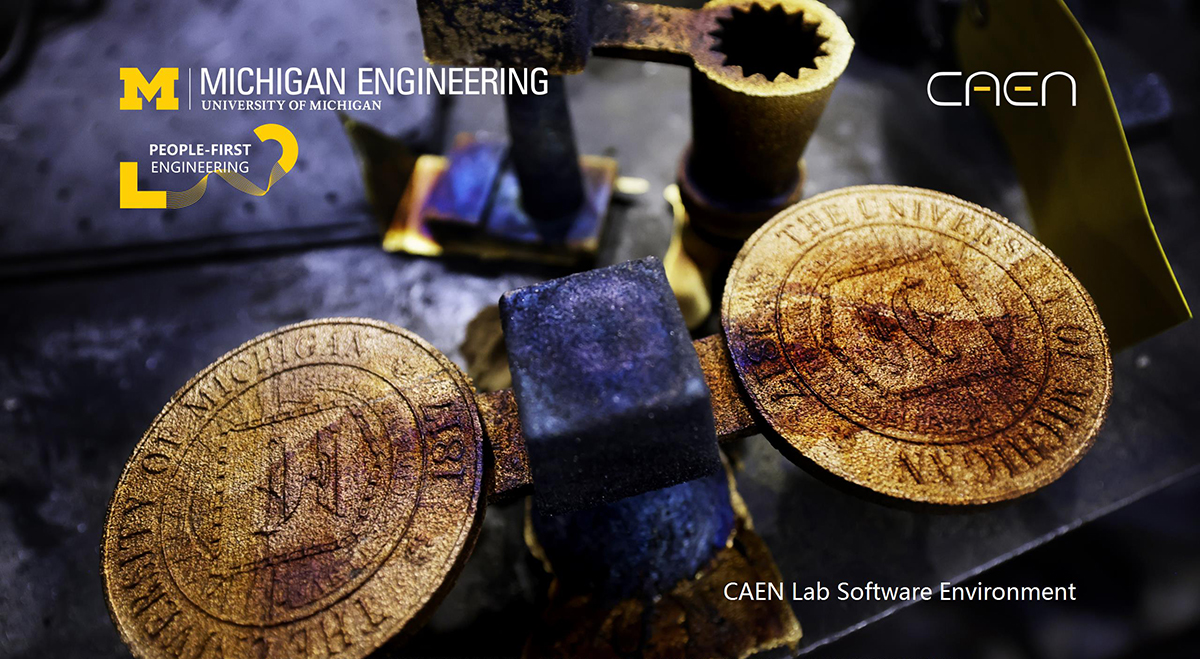- The CAEN Lab Software Environment (CLSE) for Windows currently uses 64-bit Microsoft Windows 10.
- Software applications are launched through an on-demand service called AppsAnywhere.
- Students log in using their University of Michigan (U-M) uniqname and UMICH password.
- The Windows CLSE is available in many locations across campus.
- Computers are managed, monitored, and patched regularly for security.
- The operating system and software versions are updated each year during the Summer term.
Operating System
The Windows CLSE currently uses 64-bit Microsoft Windows 10 Enterprise, which is optimized for launching CAEN-licensed applications via the AppsAnywhere software-on-demand service.
Logging In

Students log into the Windows CLSE using their U-M uniqname and UMICH password. This is the same username/password combination that is used to access many other campus services, such as Wolverine Access and MWireless.
All computers in CAEN labs are dual-boot, so students may need to reboot to select the Windows CLSE.
Locations
Computers running the Windows CLSE are available in many locations, including CAEN student computer labs, learning centers, and departmental instructional labs. They are also available in campus-wide locations such as the Duderstadt Center, the Wilson Student Team Project Center, and certain ITS computing sites.
It is also available remotely to eligible individuals via the Windows Remote Desktop Service.
Software Library
The software library bundled with the Windows CLSE includes a large set of engineering-specific applications covering a wide range of disciplines, as well as tools for general productivity. All software can be accessed from the on-demand service called “AppsAnywhere.”
Launching Software via AppsAnywhere
AppsAnywhere is a software-on-demand service that allows CAEN to easily deploy software for Microsoft Windows to computers around campus. Most applications are no longer installed locally on CLSE computers, or available in the Windows Start menu. Instead, each time you log into a CLSE Windows computer, you will be presented with the AppsAnywhere web page listing the available software titles.
Instructions on launching software using AppsAnywhere in the Windows CLSE are available in our knowledge base.
Online File Storage
A student’s files can be easily and safely stored in their CAEN Home Directory, which can be directly accessed from every computer running the CLSE. This allows a student to log in anywhere the CLSE is deployed, and immediately begin working. Data stored in CAEN Home Directories can also be accessed remotely, and is automatically backed up regularly.
In addition, the CLSE provides access to the Kumo service, which allows any user to map their U-M cloud-based storage services as network drives (e.g. Google Drive or Dropbox).
Security
Security settings and best practices from information technology experts across the University have been employed. The operating system and any applications that are vulnerable to attack are patched in a timely manner to mitigate vulnerabilities that could be used to compromise the system. Crowdstrike is installed and updated daily to protect users from anti-virus and anti-malware threats. Other features, such as Cortana, are specifically configured to address privacy.
Deployment & Management Infrastructure
Behind the Windows CLSE is a sophisticated infrastructure comprised of an array of technologies such as Active Directory, Microsoft Deployment, Systems Center Configuration Manager, application virtualization, etc. Together these technologies facilitate the creation, deployment and maintenance of the Windows CLSE which in turn leads to a better product.
Updates & Upgrades
The Windows CLSE undergoes a complete update each academic year to ensure that it is delivering the applications and features students need for their coursework. Along with the software revisions and upgrades, changes are made to improve performance, support, and the overall user experience.
